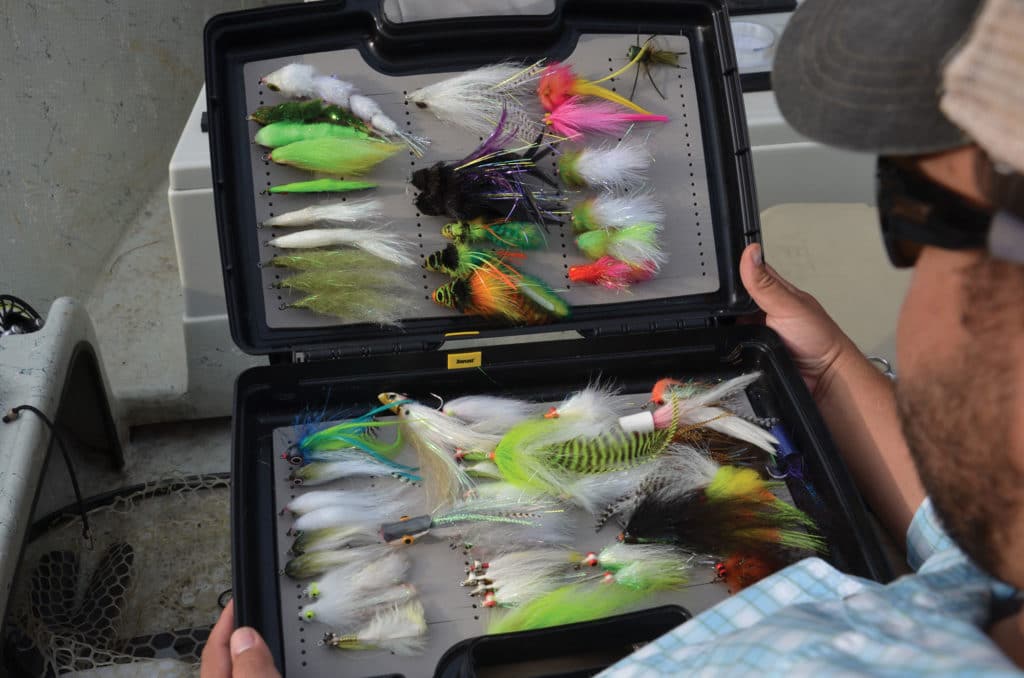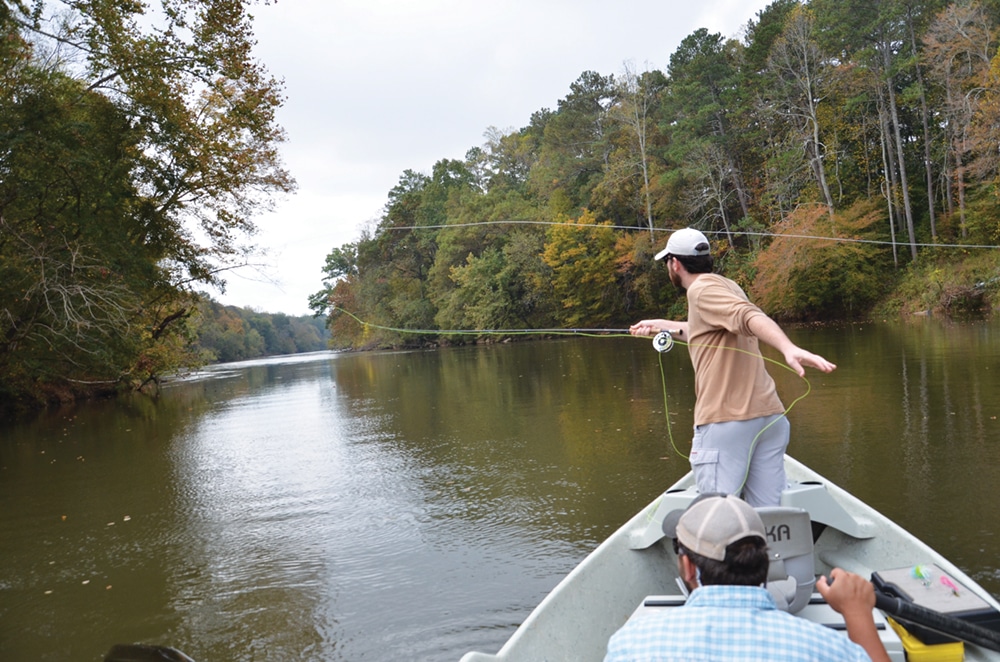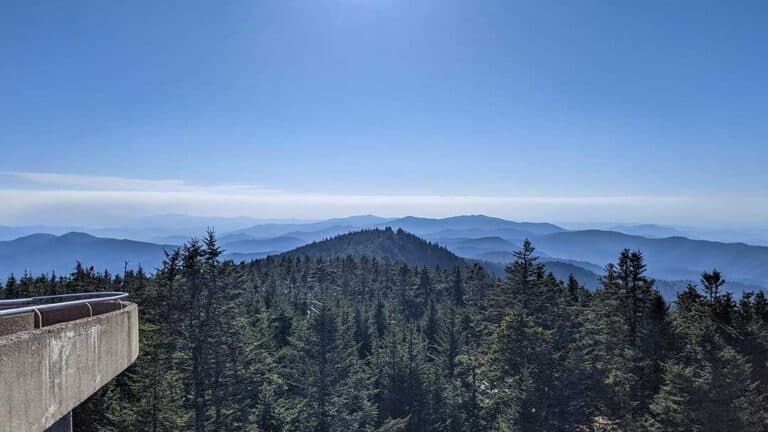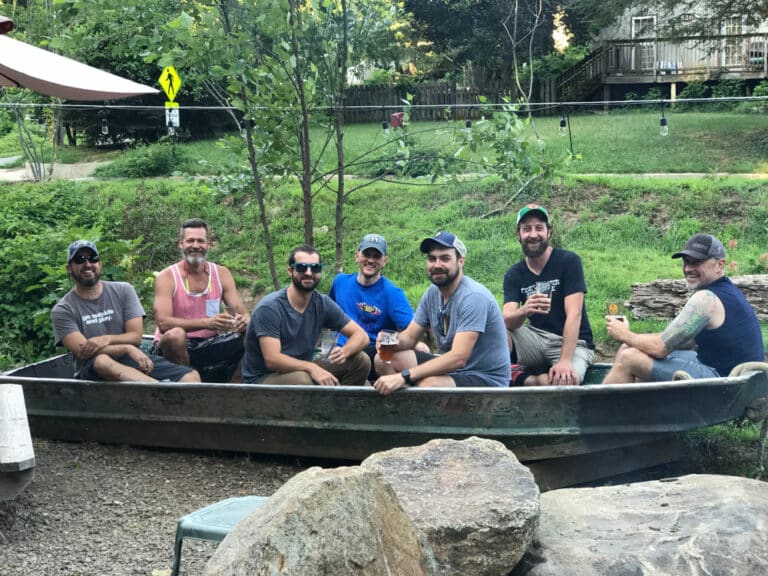Anglers act fast. You have a limited time for striped bass fishing at these special streams in the South.
Striped bass are some of the greatest game fish on the planet. They are big and strong and feed aggressively and opportunistically.
In their natural habitat on the Atlantic Coast, stripers (a.k.a. rockfish) spend most of their lives in saltwater. Each spring, they make large spawning migrations up freshwater rivers. These spring runs generate a lot of excitement for coastal anglers from the Mid-Atlantic to Maine.
Farther inland, stripers are the same species in a different type of fishery. Mostly reared and stocked by the states, freshwater striped bass are trapped in a web of dams, rivers, and reservoirs. They are landlocked, but they thrive and grow large on abundant forage in these systems. Most will never successfully spawn or return to saltwater, yet the primal urge to migrate remains. This creates an exciting opportunity for fly fishers when reservoir stripers push into the skinny water of rivers and creeks.
In most systems, it begins as a spring spawning run. A second, larger wave of fish arrives seeking cool-water refuge in deep summer. Especially in Southern systems, where reservoirs become warm and oxygen depleted, large numbers of striped bass run as far up the creeks and rivers as they can go. They remain in running water, feeding ravenously until falling temperatures incite a move back to the lakes in fall.
Fly fishing for river-run striped bass is hard work. It involves casting large baitfish patterns and streamers with heavy 9- and 10-weight rods. Bites might be infrequent, and it can be tough to remain vigilant. However, there are huge rewards for those who put in the hours.
These summer runs occur in many systems, so it’s worth prospecting any river that empties into a striped bass reservoir. The following are a few well-established fisheries along with tips from the pros who fish them.

Hiwassee River
Reliance, Tennessee
Striper fishing the Hiwassee is a lot like deer hunting, according to guide Bill Stranahan. Anglers are called on to fish hard for just a few bites from fish that often weigh 20, 30, 40 pounds or more.
“If you can get one in the boat, it’s been a good day,” Stranahan said. “But there are those days when you might hit two or three. It’s about getting out there and putting in the work.”
Most years, the wide, shoal-broken river around Reliance loads up with striped bass from July into September. These are big-river fish that run some 50 miles upstream from the Tennessee River at Lake Chickamauga. They revel in cold, oxygenated water that flows down the mountains from Apalachia Lake on the North Carolina/Tennessee border.
On the Hiwassee, fish seek out structure like wood, shoals, and rock faces. They settle into the same holes year after year, and Stranahan said it’s wise to pick your shots.
“Fish good water and fish it well,” he said. “When you’re on good structure, take your time and make good shots. Don’t rush it, because you can spook them with one bad throw.”
To mimic skipjack herring, gizzard shad, and stocked trout, Stranahan fishes big streamer and baitfish patterns that measure from 6 to 9 inches. But he said there’s also a time to size down. Much of the forage base consists of baitfish of 4 inches or less.
Go Guided: Southeastern Anglers, (770) 655-9210, southeasternanglers.com.

Etowah River
Cartersville, Georgia
In discussion of stripers, guide Garner Reid loves to use the word “ambush.” That’s how stripers feed on the Etowah River. They hold in the current-shade of logjams and fallen timber, waiting in ambush for hapless baitfish that swim past.
Anglers are expected to do a lot of casting and stripping on the Etowah. There’s a lot of wood cover, as well as natural shoals and a series of prehistoric Native American fish weirs. All that fish-holding structure is spread out over about 45 river miles up to an old lowhead dam downstream of Georgia’s Lake Allatoona. The season usually runs from late April through early September.
The fish actually cover about 75 miles from Alabama’s Lake Weiss as they move up through the system. There is successful reproduction in this run, which means anglers hook up with all sizes of striped bass, from 4 pounds all the way up to 20 pounds and larger.
Reid said proper presentation of flies is critical for catching fish, and an aggressive retrieve is what convinces ambush feeders to eat.
“What triggers them is a fly that looks like it’s wounded or fleeing,” he said. “You need to make some commotion, push some water and make that fly hunt for you.”
The predominant forage on the Etowah is threadfin shad, so 2- to 3-inch baitfish patterns and streamers in natural shad colors are the go-to flies. However, big 5- or 6-inch patterns sometimes draw the attention of larger fish.
Go Guided: Cohutta Fishing Company, (770) 866-0301, cohuttafishingco.com.
Saluda River
Columbia, South Carolina
In spring and summer, scads of striped bass make the 60-mile run up the Congaree River from the Santee-Cooper Lakes southeast of Columbia, S.C. By late summer, most of those fish push into the Saluda River, which is a short, 10-mile-long tributary that’s fed with cold water from the dam at Lake Murray.
The fish density becomes so thick in the Saluda that guide Jake Howard said 100-fish days of 2- to 5-pound stripers are possible. August is the heart of the Saluda season, when Howard actually sizes up to catch fewer fish.
“Basically, I’m muskie fishing for them, using 10-weights, sinking lines and big flies,” he said. “I’m trying to weed out the smaller ones and get to the big fish.”
There’s a time to fish smaller flies, but Howard throws a lot of 6- to 8-inch articulated streamers on 350-grain sinking lines to hopefully catch the eye of 20- to 50-pounders.
The catch to this fishery is fishing pressure. On the outskirts of a metropolitan area, the Saluda draws a crowd of anglers. The big fish spook easily, and they get finicky later in the season.
Howard sometimes carries a bait tank full of blueback herring to get fish excited enough to eat a fly. He chums with handfuls of injured herring.
“They’ll come up and blast them on the surface,” he said. “The water’s so clear that you’ll see them moving around and eating as soon as you throw them in there.”
Then it’s up to the angler to present the fly. Howard said it takes 60-foot casts with heavy gear to stay on fish efficiently.
Go Guided: Saluda Valley Guides, (803) 312-2435, saludavalleyguidesllc.weebly.com.
Cover photo: East Tennessee’s Hiwassee River is known for producing big stripers for fly anglers. Photo by Nick Carter








